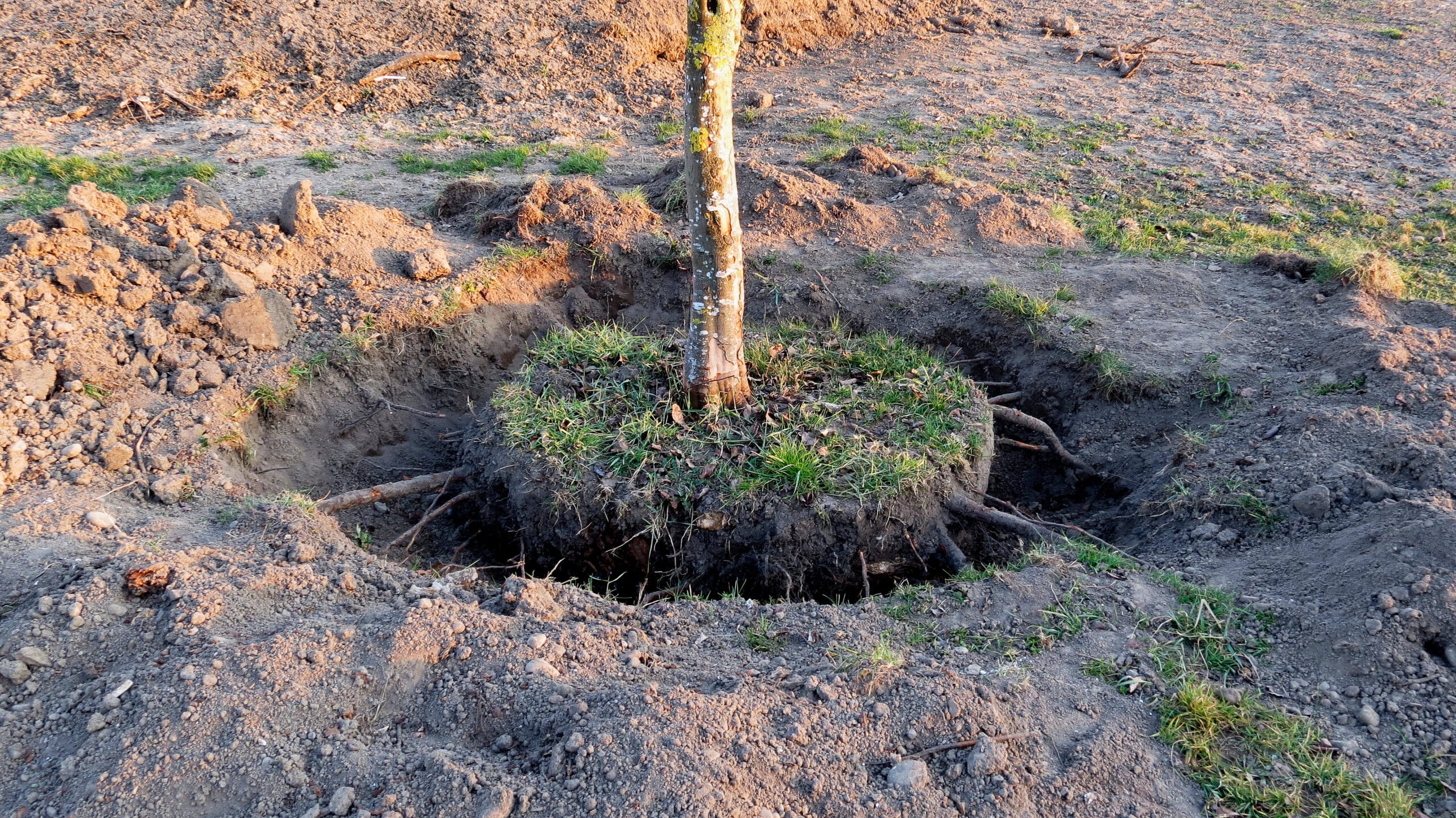Tree transplantation is far more complex than simply uprooting and replanting a plant elsewhere. It’s a multifaceted process that integrates biology, ecology, and engineering—moving a tree—especially a mature one—demands expertise, precise timing, and the use of specialized tools. Without thorough preparation, even the healthiest trees can succumb to transplant shock, ranging from temporary setbacks to potentially fatal consequences. While trees possess an extraordinary ability to adapt and heal, understanding the root causes of transplant shock and taking preventive measures is essential to ensure their survival and long-term health.
At Environmental Design, Inc. (EDI), the preservation of tree health and beauty is a cornerstone of their work. Renowned for their pioneering methods in tree transplantation, EDI specializes in helping trees of all sizes, from cherished heritage specimens to smaller landscape elements, thrive after relocation. Their innovative practices and extensive experience make them a trusted partner for safeguarding trees during moving. In this blog, we’ll delve into the science behind transplant shock, identify its symptoms, and outline effective strategies to mitigate its effects, ensuring that your tree relocation project maintains both ecological integrity and aesthetic value.
Understanding Tree Transplant Shock
Transplant shock is a universal challenge that arises when a tree’s established nutrient and water uptake routine is suddenly disrupted. Imagine abruptly moving from a comfortable home with steady resources to a completely new environment, unfamiliar and stripped of your usual comforts. That’s essentially what a tree experiences when uprooted.
A significant portion of the tree’s root system—particularly the feeder roots—is often left behind during transplantation. These fine roots are the most active in absorbing water and nutrients. Without them, the tree has to adjust to surviving on a limited supply of essential resources. This adjustment period, marked by physiological stress, is what we recognize as transplant shock.
This process can be even more taxing for large, mature trees due to their extensive root systems. These trees have often spent decades developing a vast underground network that supports their towering canopies. Transplanting them is like moving a skyscraper—it’s not just about the visible part but also the vast foundation beneath.
Why is the Root System So Critical?
A tree’s root system is its lifeblood. It serves multiple vital functions, including anchoring the tree in the soil, absorbing nutrients and water, and storing energy reserves for growth and recovery. There are two primary types of roots:
- Structural Roots: These large roots provide stability and prevent the tree from toppling over. They also act as conduits for transporting water and nutrients to the rest of the tree.
- Feeder Roots: These tiny, fibrous roots are the workhorses of nutrient absorption. Found near the surface, they actively draw in water and essential minerals to sustain the tree.
When a tree is moved, it typically loses a significant percentage of its feeder roots. This loss dramatically reduces the tree’s ability to absorb water, leaving it vulnerable to dehydration and nutrient deficiencies.
Symptoms of Transplant Shock
Recognizing transplant shock early is crucial for taking corrective action. Here are detailed symptoms to look for and what they indicate about the tree’s condition:
- Leaf Discoloration: Yellowing or browning leaves are often the first sign of water stress. Without sufficient feeder roots, the tree cannot maintain its usual water intake, leading to dehydration.
- Leaf Drop: Trees may shed leaves prematurely as a survival tactic to reduce water loss. This self-preservation mechanism helps the tree conserve its remaining resources.
- Wilting: Drooping leaves and branches signal that the tree struggles to maintain adequate hydration levels. Wilting can occur even with sufficient watering if the roots cannot absorb enough water.
- Brittle Branches: Branches that snap easily or show signs of drying out indicate severe stress. The tree may be diverting resources away from its extremities to focus on survival.
- Stunted Growth: A lack of new buds, leaves, or shoots clearly indicates that the tree is allocating its energy toward recovery rather than growth.
If these symptoms appear, immediate action is necessary. Early intervention can make the difference between recovery and irreversible damage.
Preparation: The Key to Success
Soil is the foundation of a tree’s health. Ensuring compatibility between the original and new planting sites is critical to minimizing stress during transplantation. Soil conditions vary widely, and even slight differences can significantly impact the tree’s ability to adapt.
Here’s what to focus on:
- pH Levels: Trees are sensitive to the acidity or alkalinity of the soil. For instance, oak trees thrive in slightly acidic soils, while others, like ash trees, prefer neutral to alkaline conditions.
- Nutrient Content: Conduct a soil test to identify any deficiencies in key nutrients like nitrogen, phosphorus, and potassium. Amend the soil as needed to create a nutrient-rich environment.
- Texture and Drainage: Sandy soils drain quickly but may lack nutrients, while clay-heavy soils retain water but can suffocate roots. The goal is to achieve a balance that allows water to drain while retaining enough moisture for the roots.
Root Pruning: Building Resilience
Root pruning is an essential step in preparing a tree for relocation. By cutting back some of the roots months before the move, you encourage the growth of new feeder roots within the future root ball. These roots are easier to transplant and play a crucial role in nutrient absorption post-move.
Key tips for root pruning:
- Timing: Begin root pruning in the dormant season, when the tree’s energy demands are lower.
- Technique: Use sharp tools to make clean cuts, minimizing damage to the root system.
- Aftercare: Water the tree thoroughly after pruning to support recovery and encourage new root growth.
This process not only reduces transplant shock but also makes the tree more resilient in its new environment.
Timing the Move
Timing is critical when transplanting trees. The dormant season—late fall to early spring—is ideal because the tree’s metabolic activities are at their lowest. During this period, the tree is not actively growing, which reduces its water and nutrient demands.
However, timing isn’t just about the tree; environmental factors also play a role. For example, transplanting during a dry spell can exacerbate water stress, while heavy rains can lead to waterlogged soil and root rot.
Relocation: Ensuring a Smooth Transition
Water management is arguably the most critical aspect of a successful tree move. A well-hydrated tree is better equipped to withstand the stress of relocation.
- Before the Move: Deeply water the tree a few days before transplantation to saturate the root ball. This ensures that the tree has a reservoir of moisture to draw from during the move.
- During the Move: Wrap the root ball in damp burlap to retain moisture and prevent root desiccation. For larger trees, consider using a temporary irrigation system.
- After Planting: Water the tree immediately after transplanting to help settle the soil around the roots and eliminate air pockets.
Leveraging Technology: The Role of Tree Spades
Modern tree transplantation relies heavily on advanced equipment like hydraulic tree spades. These machines are designed to dig a large, intact root ball, preserving as much of the tree’s root system as possible. For large or mature trees, using a tree spade significantly increases the chances of a successful move.
The benefits of tree spades include:
- Reduced root damage during excavation
- Precision in maintaining root ball integrity
- Faster and more efficient transplantation
Stabilization: Anchoring the Tree
Newly transplanted trees are vulnerable to environmental stresses like wind, heavy rain, and shifting soil. Stabilizing the tree with stakes or guy wires provides the support it needs to establish itself.
However, over-stabilization can be counterproductive. Trees need some natural movement to strengthen their trunks and roots. When staking, ensure the ties are loose enough to allow slight movement but secure enough to prevent tipping.
Post-Transplant Care: Helping Trees Thrive
Mulch is an often-overlooked but highly effective tool in post-transplant care. A 2-3 inch layer of organic mulch around the base of the tree offers numerous benefits:
- Moisture Retention: Mulch helps the soil retain moisture, reducing the need for frequent watering.
- Temperature Regulation: It insulates the roots, keeping them cool in summer and warm in winter.
- Weed Suppression: By blocking sunlight, mulch prevents weeds from competing with the tree for nutrients.
Be careful not to pile mulch directly against the tree trunk, as this can lead to rot and attract pests.
Monitoring and Adjusting
Transplanted trees require regular monitoring to track their recovery. Inspect the tree weekly for signs of stress, pests, or diseases. If issues arise, take immediate action:
- Adjust watering schedules to address over- or under-watering.
- Apply fertilizers if nutrient deficiencies are identified.
- Treat pest infestations with eco-friendly solutions to avoid harming the tree further.
Long-Term Maintenance: Sustaining Tree Health
Pruning is not just about aesthetics—it’s a vital part of tree care. Removing dead or damaged branches allows the tree to allocate resources to healthy growth. Regular pruning also improves air circulation, reducing the risk of fungal infections.
Even years after transplantation, trees benefit from periodic nutrient supplementation. Use fertilizers designed for your tree species, and always follow the recommended application rates to avoid over-fertilization.
Sustainable landscaping practices, such as xeriscaping and companion planting, create an environment where transplanted trees can thrive. These practices not only support tree health but also contribute to a more biodiverse and resilient ecosystem.
Conclusion
Tree transplantation is a meticulous process that requires preparation, care, and expertise. By understanding the science of transplant shock and following best practices for preparation, relocation, and aftercare, you can ensure your trees thrive in their new environment.
Environmental Design, Inc.
At Environmental Design, Inc., every tree transplant is handled with the utmost care and precision. With decades of experience and innovative techniques, EDI ensures your trees are in the best hands. Ready to protect your investment? Schedule a Call today and let the experts guide you through the process.




Recent Comments